
Acqua alta
Encyclopedia
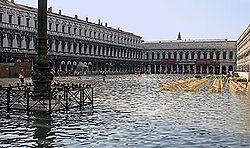
Veneto
Veneto is one of the 20 regions of Italy. Its population is about 5 million, ranking 5th in Italy.Veneto had been for more than a millennium an independent state, the Republic of Venice, until it was eventually annexed by Italy in 1866 after brief Austrian and French rule...
for the exceptional tide
Tide
Tides are the rise and fall of sea levels caused by the combined effects of the gravitational forces exerted by the moon and the sun and the rotation of the Earth....
peaks that occur periodically in the northern Adriatic Sea
Adriatic Sea
The Adriatic Sea is a body of water separating the Italian Peninsula from the Balkan peninsula, and the system of the Apennine Mountains from that of the Dinaric Alps and adjacent ranges...
.
The peaks reach their maximum in the Venetian Lagoon
Venetian Lagoon
The Venetian Lagoon is the enclosed bay of the Adriatic Sea in which the city of Venice is situated. Its name in the Venetian language, Laguna Veneta— cognate of Latin lacus, "lake"— has provided the international name for an enclosed, shallow embayment of saltwater, a lagoon.The Venetian Lagoon...
, where they cause partial flooding of Venice
Venice
Venice is a city in northern Italy which is renowned for the beauty of its setting, its architecture and its artworks. It is the capital of the Veneto region...
and Chioggia
Chioggia
Chioggia is a coastal town and comune of the province of Venice in the Veneto region of northern Italy.-Geography:...
; flooding also occurs elsewhere around the northern Adriatic, for instance at Grado
Grado, Italy
Grado is a town and comune in the north-eastern Italian region of Friuli-Venezia Giulia, located on a peninsula of the Adriatic Sea between Venice and Trieste....
and Trieste
Trieste
Trieste is a city and seaport in northeastern Italy. It is situated towards the end of a narrow strip of land lying between the Adriatic Sea and Italy's border with Slovenia, which lies almost immediately south and east of the city...
, but much less often and to a lesser degree.
The phenomenon occurs mainly between autumn and spring, when the astronomical tides are reinforced by the prevailing seasonal winds which hamper the usual reflux.
The main winds involved are the scirocco
Sirocco
Sirocco, scirocco, , jugo or, rarely, siroc is a Mediterranean wind that comes from the Sahara and reaches hurricane speeds in North Africa and Southern Europe. It is known in North Africa by the Arabic word qibli or ghibli Sirocco, scirocco, , jugo or, rarely, siroc is a Mediterranean wind...
, which blows northbound along the Adriatic Sea, and the bora
Bora (wind)
Bora or Bura is a northern to north-eastern katabatic wind in the Adriatic, Bosnia and Herzegovina, Croatia, Montenegro, Italy, Greece, Slovenia, and Turkey....
, which has a specific local effect due to the shape and location of the Venetian lagoon.
Causes
Precise scientific parameters define the phenomenon called acqua alta, the most significant of which (i.e., the deviation in amplitude from a base measurement of "standard" tides) is measured by the hydrographic station located nearby the Basilica di Santa Maria della SaluteBasilica di Santa Maria della Salute
The Basilica of St Mary of Health , commonly known simply as the Salute, is a Roman Catholic church and minor basilica located in the Dorsoduro sestiere of the Italian city of Venice. It stands on a narrow finger of land between the Grand Canal and the Bacino di San Marco making the church visible...
.
Supernormal tidal events can be categorized as:
- intense when the measured sea level is between 80 cm. and 109 cm. above the standard sea level (which was defined by averaging the measurements of sea level during the year 1897);
- very intense when the measured sea level is between 110 cm. and 139 cm. above the standard;
- exceptional high waters when the measured sea level reaches or exceeds 140 cm. above the standard.
Generally speaking, tide levels largely depend on three contributing factors:
- An astronomical component, which results from the movement and alignment of celestial bodies, principally the MoonMoonThe Moon is Earth's only known natural satellite,There are a number of near-Earth asteroids including 3753 Cruithne that are co-orbital with Earth: their orbits bring them close to Earth for periods of time but then alter in the long term . These are quasi-satellites and not true moons. For more...
, secondarily the SunSunThe Sun is the star at the center of the Solar System. It is almost perfectly spherical and consists of hot plasma interwoven with magnetic fields...
, and marginally other planets (with effects decreasing in logarithmic relation to their distance from the Earth); this component is dependent upon the laws of the astronomical mechanics and can be computed and accurately predicted for the long run (even years or decades) - A geophysical component, primarily dependent upon the geometric shape of the basin, which amplifies or reduces the astronomical component and, because it is dependent upon the laws of the physical mechanics, can be also computed and accurately predicted for the long run (even years or decades);
- A meteorological component, linked to a large set of variables, such as the direction and strength of winds, the location of barometric pressure fields and their gradients, precipitation, etc. Because of their complex interrelations and quasi-stochastic behavior, these variables cannot be accurately modeled in statistical terms. Consequently, this component can only be forecast for the very short run and is the principal determinant of acqua alta emergencies that catch Venetians unprepared.

Subsidence
Subsidence is the motion of a surface as it shifts downward relative to a datum such as sea-level. The opposite of subsidence is uplift, which results in an increase in elevation...
, i.e. the natural sinking of the soil level, to which the lagoon is subject, and eustasy, i.e. the progressive rise of sea levels.
While these phenomena would occur independently of human activity, their effects have increased because of inhabitation: the use of lagoonal water by the industries in Porto Marghera (now ceased) speeded up subsidence, while global warming
Global warming
Global warming refers to the rising average temperature of Earth's atmosphere and oceans and its projected continuation. In the last 100 years, Earth's average surface temperature increased by about with about two thirds of the increase occurring over just the last three decades...
has been linked to increased eustasy.
Venice's "Tide Monitoring and Forecast Center" evaluates that the city has lost 23 cm. in its elevation since 1897, the year of reference, 12 of which are attributable to natural causes (9 because of eustasy, 3 because of subsidence), 13 are due to the additional subsidence caused by human activity, while the "elastic recovery" of the soil has allowed the city to "gain back" 2 cm.
Geophysical determinants linked to the Adriatic Sea
The long and narrow rectangularRectangle
In Euclidean plane geometry, a rectangle is any quadrilateral with four right angles. The term "oblong" is occasionally used to refer to a non-square rectangle...
shape of the Adriatic Sea is the source of an oscillating water motion (called seiche
Seiche
A seiche is a standing wave in an enclosed or partially enclosed body of water. Seiches and seiche-related phenomena have been observed on lakes, reservoirs, swimming pools, bays, harbors and seas...
) along the basin's minor axis.
The principal oscillation, which has a period of 21 hours and 30 minutes and an amplitude around 0.5 meters at the axis' extremities, supplements the natural tidal cycle, so that the Adriatic sea has much more extreme tidal events than the rest of the Mediterranean.
A secondary oscillation is also present, with an average period of 12 hours and 11 minutes.
Because the timeframe of both oscillations is comparable to naturally occurring (yet independent) astronomical tides, the two effects overlap and reinforce each other.
The combined effects are more significant at the perigee
Perigee
Perigee is the point at which an object makes its closest approach to the Earth.. Often the term is used in a broader sense to define the point in an orbit where the orbiting body is closest to the body it orbits. The opposite is the apogee, the farthest or highest point.The Greek prefix "peri"...
s, which correspond to new moon
New moon
In astronomical terminology, the new moon is the lunar phase that occurs when the Moon, in its monthly orbital motion around Earth, lies between Earth and the Sun, and is therefore in conjunction with the Sun as seen from Earth...
s, full moon
Full moon
Full moon lunar phase that occurs when the Moon is on the opposite side of the Earth from the Sun. More precisely, a full moon occurs when the geocentric apparent longitudes of the Sun and Moon differ by 180 degrees; the Moon is then in opposition with the Sun.Lunar eclipses can only occur at...
s and equinox
Equinox
An equinox occurs twice a year, when the tilt of the Earth's axis is inclined neither away from nor towards the Sun, the center of the Sun being in the same plane as the Earth's equator...
es.
Should meteorological conditions (such as a strong scirocco
Sirocco
Sirocco, scirocco, , jugo or, rarely, siroc is a Mediterranean wind that comes from the Sahara and reaches hurricane speeds in North Africa and Southern Europe. It is known in North Africa by the Arabic word qibli or ghibli Sirocco, scirocco, , jugo or, rarely, siroc is a Mediterranean wind...
wind blowing north along the major axis of the Adriatic basin) hamper the natural outflow of excess tidal water, high waters of greater magnitude can be expected in Venice.
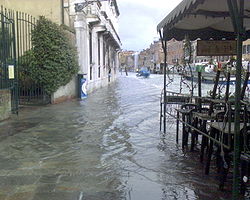
Specific characteristics of the Venetian lagoon
The particular shape of the Venetian lagoon, the subsidenceSubsidence
Subsidence is the motion of a surface as it shifts downward relative to a datum such as sea-level. The opposite of subsidence is uplift, which results in an increase in elevation...
which has been affecting the soil in the coastal area, and the peculiar urban configuration all magnify the impact of the high waters on city dwellers and on the buildings.
Furthermore, the northbound winds called bora
Bora (wind)
Bora or Bura is a northern to north-eastern katabatic wind in the Adriatic, Bosnia and Herzegovina, Croatia, Montenegro, Italy, Greece, Slovenia, and Turkey....
and scirocco often blow directly towards the harbors that connect the lagoon to the Adriatic Sea, significantly slowing down (and, at times, completing blocking) the outflow of water from the lagoon toward the sea.
When this occurs, the ebb is factually prevented inside the lagoon, so that the following high tide overlaps with the previous one, in a perverse self-supporting cycle..
It should be noted that the creation of the industrial area of Porto Marghera, which lies immediately behind Venice, amplified the effects of high waters for at least two reasons: first, the land upon which the area is built was created by filling large parts of the lagoon where smaller islands just above sea level previously lay.
These islands, called barene, acted as natural sponges (or "expansion tanks") when high tides occurred, absorbing a significant portion of the excess water.
Second, a navigable channel was carved through the lagoon to allow oil tankers to reach the piers.
This "Oil Channel" factually linked the sea to the coastal line, running through the harbor in Malamocco and crossing the lagoon for its entire width.
This direct connection to the sea, which was obviously non-existent at the time of Venice's foundation, has subjected the city to more severe high tides.
Porto Marghera and its facilities are not the only human-made contributors to higher tides.
Rather, the municipality of Venice has published a study that suggests the following initiatives may have had an irreversible and catastrophic impact on the city's capacity to withstand acque alte in the future:
- the building of the Railroad Bridge (1841/1846) connecting Venice to the land, because its supporting pillars modify the natural motion of lagoonal water;
- the diversion of the river BrentaBrentaBrenta may refer to:* Brenta , Italy* Brenta Valley* Brenta Group* Brenta, Lombardy...
outside the Chioggia basin, which drained the 2,63 hectares of the river's deltaRiver deltaA delta is a landform that is formed at the mouth of a river where that river flows into an ocean, sea, estuary, lake, reservoir, flat arid area, or another river. Deltas are formed from the deposition of the sediment carried by the river as the flow leaves the mouth of the river...
that functioned as expansion tanks, absorbing extra lagoonal water during high tides; - the building of offshore dammed piers (Porto di Malamocco, 1820/72; Porto di S. Nicolò, 884/97; Porto di Chioggia, 1911/33), which obviously restrict the natural movement of water;
- the building of the Ponte della LibertàPonte della LibertàPonte della Libertà is a road bridge connecting the city of Venice to Mestre, on the mainland of Italy.Designed in 1932 by engineer Eugenio Miozzi, and opened by Benito Mussolini in 1933 as Ponte Littorio, the bridge is the only access for road vehicles to the capital city of Veneto...
(1931/33), which connects Venice to the land; - the building of the Riva dei Sette Martiri (1936/41), an extension to the Riva degli Schiavoni;
- the building of the artificial island TronchettoTronchettoTronchetto is an artificial island in the Venetian Lagoon, northern Italy, located at the westernmost tip of the main Venice island....
used as a car and bus terminal (17 hectares, 1957/61): - the doubling of the Railroad Bridge (1977).
Affected portions of the city

These factors account for the gravity and spread of a supernormal tidal phenomenon; as a city-commissioned study showed, a tide up to 90 cm. above sea level leaves Venice virtually unaffected, while 30 cm. of additional water hit more than ⅓ of the city. The study provided Venetians with the following reference guide:
| Sea Level | Area of Venice submerged (percent) |
|---|---|
| +90 cm | 1.84% |
| +100 cm | 5.17% |
| +110 cm | 14.04% |
| +120 cm | 28.75% |
| +130 cm | 43.15% |
| +140 cm | 54.39% |
| +150 cm | 62.98% |
| +160 cm | 69.43% |
| +170 cm | 74.20% |
| +180 cm | 78.11% |
| +190 cm | 82.39% |
| +200 cm | 86.4% |
| >+200 cm | 100% |
To allow pedestrian circulation during floods, the city installs a network of gangways (wide wood planks on iron supports) reproducing the main urban paths. This gangway system is generally set at 120 cm above the conventional sea level, which can result in partial or complete flooding when higher tides occur.
Monitoring, alerting and control
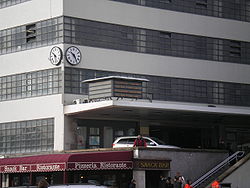
Forecasts are then announced to the population via the centre's website and dedicated phone lines, through local newspapers, on electronic displays, and at some stops of the vaporetti (public transport).
When an acqua alta event is forecast, owners of commercial and residential property that is likely to be affected are contacted by phone (a free service provided by the municipality) or SMS
SMS
SMS is a form of text messaging communication on phones and mobile phones. The terms SMS or sms may also refer to:- Computer hardware :...
.
"Very intense" events warrant alerting the whole population, which is accomplished by sounding a dedicated system of sirens located throughout the city.
On December 7, 2007, the alert system was modified (in Venice alone) to signal the magnitude of expected "very intense" tidal events to the population: sirens sound a first "await instructions" whistle to catch the population's attention, then produce a sequence of whistles whose number increases with the expected tide level (according to a published equivalence table).
While not radically innovative, the new system communicates in greater detail the extent of the expected flooding to the population.
The previous system, still used in the rest of the Venetian lagoon, only provides three levels of warning: the signal is sounded once for a tide above 110 cm., twice for tidal forecasts above 140 cm. and thrice for those above 160 cm.
The new system was first used on March 24, 2008, communicating an accurately forecast tide level above 110 cm.
Countermeasures
The MOSE projectMOSE Project
The MOSE Project is a project intended to protect the city of Venice, Italy from floods...
(which stands for Modulo Sperimentale Elettromeccanico, i.e. "Experimental Electromechanical Module") has been in the works for several years, partly because of budget constraints, and partly because of the sheer complexity of the undertaking.
The project should significantly reduce the effects of "exceptional high waters" (but not those of lesser, yet detrimental, tidal events) by completing the installation of 79 separate 300-ton flaps hinged on the seabed between the lagoon and the Adriatic sea.
While normally fully submerged and invisible, the flaps can be raised preemptively to create a temporary barrier, which is expected to protect the city from exceptional acque alte.
Statistics
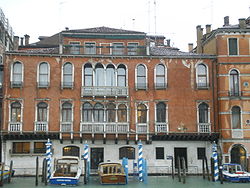
above sea level) was measured. However, because the first modern marigraph
Tide gauge
A tide gauge is a device for measuring sea level and detecting tsunamis.Sensors continuously record the height of the water level with respect to a height reference surface close to the geoid...
for regular tide monitoring was installed in Venice only in 1871, most documentation on the subject adopts the following year as the golden standard.
The Venetian Institute for Science, Literature and Arts was appointed to the task by the newly formed Italian Kingdom, thus replacing the Magistrato alle Acque in 1866 upon annexion of the city. The Institute ceased to exercise its monitoring and record-keeping functions in 1908, when the task, along with records and instruments, was passed to the Hydrographic Office of Venice.
After the unprecedented acqua alta of 1966, the city set up a dedicated service to analyse data, monitor fluctuations, and forecast high tides, which is also charged with continuously keeping the population informed. Renamed Tide Monitoring and Forecast Center in 1980, the service has absorbed the record-keeping functions of the Hydrographic Office.
Historical records
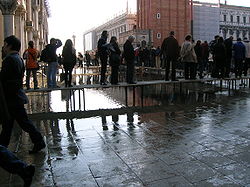
Early records
The first record of a large flood in the Venetian lagoon dates back to the so-called Rotta della Cucca, reported by Paul the DeaconPaul the Deacon
Paul the Deacon , also known as Paulus Diaconus, Warnefred, Barnefridus and Cassinensis, , was a Benedictine monk and historian of the Lombards.-Life:...
as having occurred on October 17, 589. According to Paul, all rivers with mouths in the northern Adriatic, from the Tagliamento to the Po
Po River
The Po |Ligurian]]: Bodincus or Bodencus) is a river that flows either or – considering the length of the Maira, a right bank tributary – eastward across northern Italy, from a spring seeping from a stony hillside at Pian del Re, a flat place at the head of the Val Po under the northwest face...
, overflowed at the same time, completely modifying the hydro-geologic equilibrium of the lagoon.
Middle Ages
The first documented description of acqua alta in Venice concerns the year 782 and is followed by other documented events in 840, 885, and 1102.In 1110 the water, following a violent sea storm (or, possibly, a seaquake and its subsequent tsunami
Tsunami
A tsunami is a series of water waves caused by the displacement of a large volume of a body of water, typically an ocean or a large lake...
), completely destroyed Metamauco (ancient name for Malamocco), Venice's political centre before the Doge
Doge
Doge is a dialectal Italian word that descends from the Latin dux , meaning "leader", especially in a military context. The wife of a Doge is styled a Dogaressa....
's residence was moved to Rialto
Rialto
The Rialto is and has been for many centuries the financial and commercial centre of Venice. It is an area of the San Polo sestiere of Venice, Italy, also known for its markets and for the Rialto Bridge across the Grand Canal....
.
Local chroniclers report that in 1240 "the water (that) flooded the streets (was) higher than a man". Other events are recorded to have occurred in 1268, 1280, 1282, and on December 20, 1283, which was probably an abnormally significant event, since a chronicle reported that Venice was "saved by a miracle".
Chroniclers report that high tides occurred in 1286, 1297, and 1314; on February 15, 1340; on February 25, 1341; on January 18, 1386; and on May 31 and August 10, 1410.
In the 15th century, high tides were recorded in 1419 and 1423, on May 11, 1428 and on October 10, 1430, as well as in 1444 and 1445. On November 10, 1442 the water is reported to have risen "four feet above the usual".
Modern Era
High waters were recorded on May 29, 1511; in 1517; on October 16, 1521; on October 3 and, again, on December 20, 1535. Local chronicles also attest to floods occurring in 1543; on November 21, 1550; on October 12, 1559; and in 1599.The year 1600 was characterized by a high frequency of events, with floods on December 8 as well as December 18 and 19. The latter event was probably remarkable, since there are also records of very violent sea storms that, having "broken indeed the shores in several places, entered the towns of Lido Maggiore, Tre Porti, Malamocco, Chiozza, et cetera".
Another noteworthy acqua alta took place on November 5, 1686.
Several chronicles of the time, among them one written by a scientist, concur in reporting that "the waters reached the outdoor floor of ... [Sansovino's] Lodge", which is the monumental entrance to the Campanile di San Marco. A similar level was reached during the exceptional flood of November 4, 1966, which allowed scholars in the late 1960s to recreate a likely scenario for the 1686 flood.
After accounting for the rebuilding of the Lodge after the 1902 fall of the Campanile and for subsidence, estimates concluded that the tide may have been as high as 254 cm. above today's standard sea level.
In the 18th century, records became more abundant and precise, reporting acque alte on December 21, 1727; New Year's Eve, 1738; October 7, 1729; November 5 and 28, 1742; October 31, 1746; November 4, 1748; October 31, 1749; October 9, 1750; Christmas Eve, 1792; and on Christmas Day, 1794.
Finally, in the decades before the installation of the marigraphs, high waters are recorded to have occurred on December 5, 1839, as well as in 1848 (140 cm) and 1867 (153 cm).
Exceptional high waters since 1923

According to the records of the Tide Monitoring and Forecast Centre of Venice, these are the maximal documented levels (in decreasing, not chronological, order):
- 194 cm on November 4, 1966
- 166 cm on December 22, 1979
- 158 cm on February 1, 1986
- 156 cm on December 1, 2008
- 151 cm on November 12, 1951
- 147 cm on April 16, 1936
- 147 cm on November 16, 2002
- 145 cm on December 25, 2009
- 145 cm on October 15, 1960
- 144 cm on December 23, 2009
- 144 cm on November 3, 1968
- 144 cm on November 6, 2000
- 142 cm on December 8, 1992
- 140 cm on February 17, 1979
- Maximum high tide level: 1.94 m recorded on November 4, 1966
- Minimum ebb tide level: -1.21 m, recorded on February 14, 1934
- Maximum difference between a high tide and the following ebb tide: 1.63 m, recorded on January 28, 1948 and on December 28, 1970
- Maximum difference between an ebb tide and the following high tide: 1.46 m, recorded on February 23 and 24, 1928, as well as on January 25, 1966

